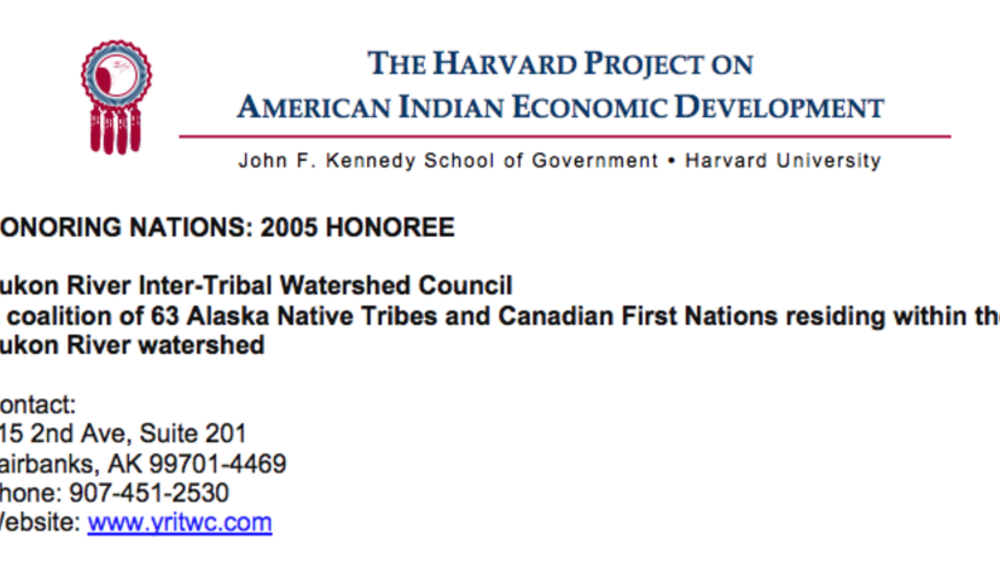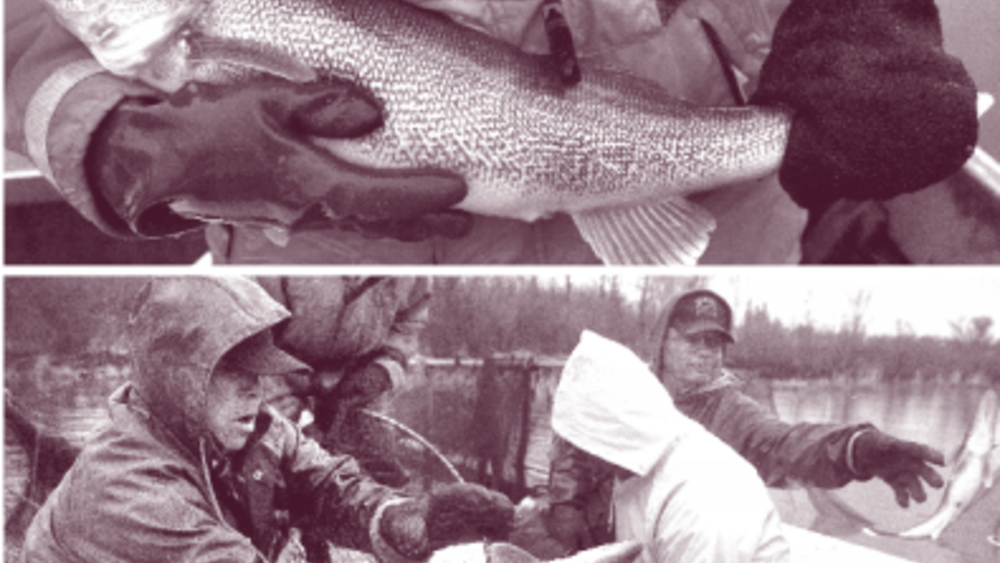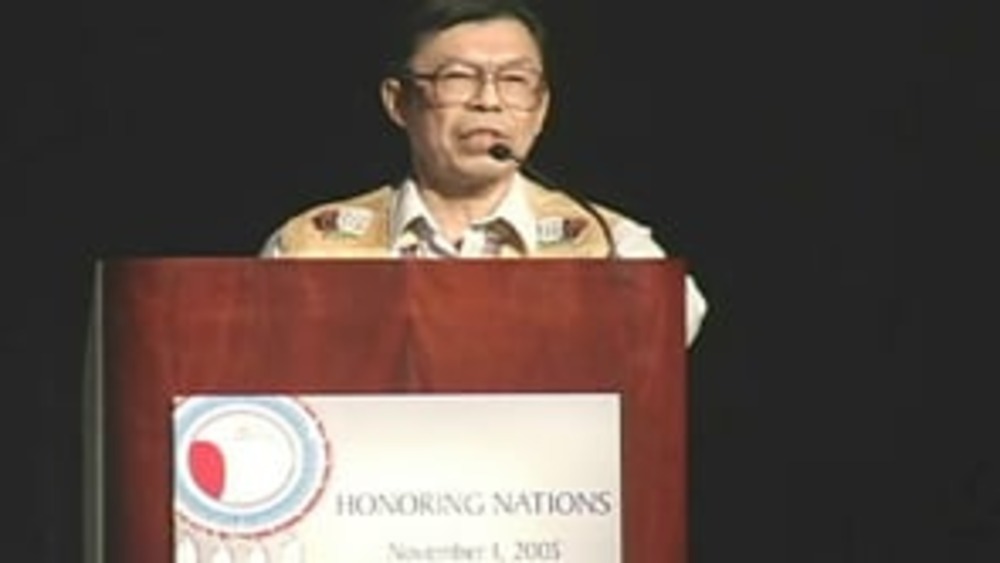Middle Yukon Representative Pat Sweetsir of the Yukon River Inter-Tribal Watershed Council (YRITWC) discusses how and why the Indigenous nations living in the Yukon River Watershed decided to establish the YRITWC, and the positive impacts it is having on the health of the watershed and those who live there.
Additional Information
Sweetsir, Pat. "Yukon River Inter-Tribal Watershed Council." Honoring Nations symposium. Harvard Project on American Indian Economic Development, John F. Kennedy School of Government, Harvard University. Cambridge, Massachusetts. September 18, 2009. Presentation.
Transcript
"A lot of people say, 'Oh, I live in God's country,' but we know that we live in god's cathedral. It's our job to take care of his cathedral.
The military -- we didn't have no position of strength. And so in the strategic plan, I drew up a tribal hearing, so we had a tribal hearing. And we brought the military there and we had the people go before them and tell them, 'There's 55-gallon drums all over the Yukon. Some of them have got stuff in it. There's little holes. It's leaking out on the ground. Our rabbits are eating those willows and we're eating the rabbits...' It's in our food chain, all this pollution. The sad part too, another one of the sad parts is on top of the water table -- and this is along the Yukon, most polluted spot along the Yukon River -- on top of our water table is three feet of fuels. Every spring when the water comes up these things come up through the grounds and then go back down when the water goes down -- a million gallons or more. They don't know how much it is. It covers a huge area, from here across the street, that's how far it is from the Yukon River. Yeah, it concerns us. We get it down there in our fish and our food? Oh, we didn't like that.
Well, after the hearing, we got the military's attention, but at the hearing I invited [the U.S. Department of] Labor, the Environmental Protection Agency [EPA], the State of Alaska, EPA people, the military, to witness what the people were saying, because I wanted them to help us to clean it up. 'Who better to know when our kitchen is clean than us ourselves?' is what Sidney Huntington told the people. He's one of our respected elders.
Out of that was born [the] Yukaana Development Corporation which is a previous winner of an Honoring Nations award, High Honors award. They went about and they picked up 80,000 barrels from along the Yukon River system. There was a big flood in '94 and they didn't have bulk fuel storages, they used those 55 gallon drums. When the waters came up, all of these barrels were floating and people were living on the dike -- there's a dike that surrounds the military base at Galena -- and the Native population is squeezed into this three-quarter-mile-long strip of land by a quarter of a mile land with the base on one side and the Yukon on the other. These waters came up and people were camped out on the base and the military became afraid for their safety. So they brought by these huge helicopters and they just blew those barrels out into the river, out into the ice pack, out into the flow, and they scattered all the way down to the end of the river.
When I brought these people to the hearing, I brought them there to help me plan. How do we plan our way out of this? 'You guys are all responsible just like us, we're going to clean it up for you.' And they helped us develop a strategy to clean it up. We eventually went on and did that, but this story isn't about Yukaana or the military clean up, it's about the Yukon River Watershed. And on that plan, that strategic plan, the trail to the tribal environmental sovereignty, I had the concerns that other villages had -- Thompson Wetlands areas, old machinery all about the village, oils in them, leaking oils, just all those type of contaminants. And in 1997 the tribes came together in the dead of winter, 67 below or something like that. It was cold and stayed cold the whole time they were there. That kept us all together by the way. The military was helpful. They helped us out by giving us a meeting place. Chief Si John from the Coeur d'Alene Tribe facilitated for us -- what a great leader he was -- he told us, 'If you can only just agree on one thing, that this will be a moving thing for the world,' he told us. And of course we didn't understand that, but we understood that agreeing on one thing to clean up our communities and stuff, we could do that.
We started the process of organizing the watershed. These were people that came and they told about this. 'There's fist-sized growths on our moose. Our fish, they have little things in them. They're white, they're like, they come uncurled and they're little worms.' They told their ecological knowledge, what they deal with every day on their food table, and it was very powerful. And we recorded it all too, by the way.
The organization, after that Galena meeting, we had another meeting of the leadership. They decided at that meeting to break the Yukon into different areas. There's the headwaters, that's over in Canada, British Columbia, and Yukon, where the Yukon River begins. There's huge granite mountains and in between them sit these beautiful lakes, hundreds of miles long. If you look down at the bottom, you could drink the water. It's a good place. As that river travels down it hits, it travels north and then it travels west to Fort Yukon area, and out in the Fort Yukon area is a place that's known as Yukon Flats, and there's a whole bunch of, it's where the water just sort of thins out everywhere and there's a whole bunch of islands. And in this special place is where we get our moisture for the interior. It acts like a little incubator putting moisture up in the air, all these bristling waters. And then as you get further down the river down near my place there's a special place called Bishop Mountain. Amy's [Besaw Medford] been there. She visited the smoke house there. At this point, the Yukon River narrows about from here to across the street, very narrow, this whole big huge river. And at this place is a big rock and in the springtime when the drift flows, it tends to bind together but when it hits this rock it busts and smashes it all up and splits it all out and this river continues to go on down river to our neighbors that are on the coast, because along the coast they pick up every little stick of wood that they need, the roots and everything. And so when you get down to the mouth of the river, there's three different channels that come in, but it's a huge wetland there. You can stand at Pilot Mountain and look over there for 60 miles, you see these lakes and the wetland system, all kinds of birds flying over all the time in a steady line. You know you're in a special place. All the leaders have been to these places. I visited nearly all the communities along the watershed, including Canada. I just made it a special trip to go over there, meet people who are in the village. I cannot help defend unless I know who I'm defending and why I'm defending. That's the way I do my work and that's why the chiefs have me do it.
Out of the meeting came a tribal accord. After a couple of years and some meetings and stuff, we developed a tribal accord, a national Native American resource center, or one of those lawyer groups anyway, they helped us out. This tribal accord is an agreement between these tribal governments to clean up their own communities and let's teach our children about the environment. We have people with old habits that put oil in there in their boat and then throw the container overboard. The only one that can stop the adults from doing that is the children. So we teach the children and the children say, 'Grandpa, you're not supposed to do that.' It's the only way to get into the home with this new thinking about the environment for our own people. That's how we do it.
I don't know what to say too much about the Watershed [Council], except that they're doing remarkable things. They're discovering the science of the river. We have 80 technicians along the river that are in the village taking water samples, gathering a huge database. This past summit that we had at Helen's Landing over in Yukon, one of the federal departments signed a ten-year agreement with us to take water samples. So we're going to get some long-term stuff. We've been doing it incrementally as we get money, but now we can do a better job. At Ruby, where I live, this summer they took a cross-section of the river, some pictures. If you were to take a cross-section of river, there's different flow in the river and we had to identify that so that we could put in a renewable energy experiment of generating electricity from a device that just floats on top of the water.
I guess some of the lessons learned is delivering education to our children. People say, 'Indians are caretakers of the earth,' and we say, 'Fine, empower us.' But we have to do that empowering ourselves as our children take the time and we do that in the schools. They color bags for us so we can band plastic shopping bags as a convenience. We don't have that in our village. The children make us little bags to carry around, cute little things. I think the training of people for handling hazardous waste in the village, that's another one of the things that the watershed does. We help with strategic planning when tribes are facing a problem with such things as how do you address, how do you be friends. If one tribe says, 'I want nuclear energy,' and the other tribe says, 'I don't like that.' So we develop a tribal accord, I mean tribal protocol. How do we act as governments to one another and not get mad at each other and start slamming doors, but keep that open? I think another big one is value-based decision making that the watershed group does. It's not so much corporate but value-based. They do it by consensus. Everybody has to agree. If one person or one tribe disagrees, that subject is gone. Consensus-based decision making is a new thing for some people, but not for tribes [because] that's usually what they do.
I want to tell a little story about, back to the Air Force again, because it's a cute story and I don't have much time left. Getting down and talking to a government, any federal government that you're dealing with, it takes to get down to the level of one on one. And I used to get a kick out of watching my chief Peter Captain. We'd be using this eagle feather to pass around, only one person can speak at a time. And my chief, he'd take this eagle feather and he'd be just kind of messing it up and he'd pass this eagle feather to the colonel -- the one that he's doing business with -- and the colonel will be telling his thing. Next thing that eagle feather is straight and perfect again. But it's the chief's way of getting sublime-ness into the conversations or into the atmosphere of those negotiations and stuff. It works really well. I think that's about all I've got to say. It might be enough. Thank you."



